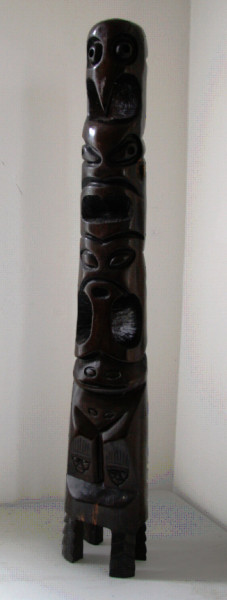In this their seventh Conversation, artists Stanley Greaves AA and Akima McPherson examine Roaland Taylor’s sculpture, Shaman and His Medicine, completed in 2004. The Shaman and His medicine will be available for viewing at the National Gallery of Art, Castellani House from Oct 5 – 10.
Akima McPherson: There are those who speak of “Guyanese Art” as though there is a cohesiveness and homogeneity about local art stylistically or thematically or both. I like to think of ‘Art in Guyana,’ as do others, because this allows for the immediate recognition of the diversity that constitutes visual art output both in terms of styles and themes. And currently within the diversity, there are ‘schools’. Roaland Taylor’s Shaman and His Medicine, is part of one such school – the Lokono School which is characterised by sculptors working along a similar aesthetic and thematic vain. Many turn to the mythology of their Arawak/Lokono culture and the landscape of the interior as source for things to say visually.

Roaland Taylor Banya 2004 (Photo courtesy of Castellani House)

AM: The sculptors of the Lokono/Arawak School have also taken on the totem pole as their signature. Lynius Clenkian, Telford Taylor (d. 2015), Foster Simon and Oswald Hussein have each done several very good works that assume this form. And they animate the vertical forms with watchers. The eyes and sometimes bodies of significant birds and mythic beings are carved in ascending tiers/registers but one senses that every tier is as important as the others which preceded it.
Looking at the totem poles you get a sense of the quiet mystery of the forest. And reference to the Shaman is typical. For a time (and perhaps still) many of the group would liken the making of art to making medicine, the very matter made by the Shaman.
SG: Like so many other things in our society, the totem pole form is an appropriation and to fully appreciate the statement we would have to know the significance of the forms and symbols used. The significances could be personal concepts or propositions or based on the belief system of a particular group or groups…the Cariban or Arawakan. The Zemi figures of the Caribbean are more authentic. They hardly survived being constructed from fibres that decay easily. A wooden one is in the National Museum in Jamaica and fibre ones in the Dominican Republic and Paris. Looking at Taylor’s work one is left to find significances. I take it that the faces seen represent the Shaman and his spiritual forms associated with birds, beasts and mythical creatures. One would like to see the totem not just as an artistic statement, but relating in a fundamental way to the spiritual life of the people to whom it belongs.




